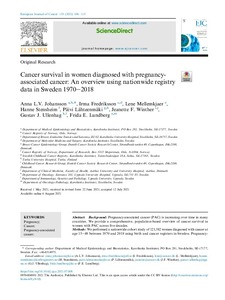Cancer survival in women diagnosed with pregnancy-associated cancer: An overview using nationwide registry data in Sweden 1970-2018
Ullenhag Gustav J.; Mellemkjaer Lene; Johansson Anna L.V.; Winther Jeanette F.; Fredriksson Irma; Stensheim Hanne; Lähteenmäki Päivi; Lundberg Frida E.
https://urn.fi/URN:NBN:fi-fe2021102752622
Tiivistelmä
Background
Pregnancy-associated cancer (PAC) is increasing over time in many countries. We provide a comprehensive, population-based overview of cancer survival in women with PAC across five decades.
Methods
We performed a nationwide cohort study of 121,382 women diagnosed with cancer at age 15–49 between 1970 and 2018 using birth and cancer registers in Sweden. Pregnancy-associated cancer was defined as diagnosed during pregnancy and within one year of delivery, while non-PAC was outside this window. Cox regression estimated adjusted hazard ratios (HRs) with 95% confidence intervals (CIs) comparing cancer mortality for PAC versus non-PAC.
Results
In total, 5079 women had a diagnosis of PAC. Cutaneous malignant melanoma, breast, cervical, thyroid and central nervous system (CNS) were the most common sites of PAC. A higher cancer mortality was observed in PAC versus non-PAC for breast (HR = 1.72, 95% CI 1.54–1.93) and uterine cancer (myometrium/unspecified) (8.62, 2.80–26.53), in which all PAC deaths were uterine sarcomas. Increased mortality was also observed in upper digestive tract cancer diagnosed during pregnancy and colon cancer diagnosed during first year after delivery. Contrary, the HR for CNS tumours was significantly decreased (0.71, 0.55–0.91). Survival after PAC improved for most sites over time, with survival after breast cancer during pregnancy in recent years being similar to that of non-pregnancy associated breast cancer.
Conclusion
For the majority of sites, PAC was not associated with poorer prognosis compared to non-PAC, a finding which was stable over time. The main exceptions were breast cancer and rarer cancers, such as uterine sarcoma.
Kokoelmat
- Rinnakkaistallenteet [19207]
